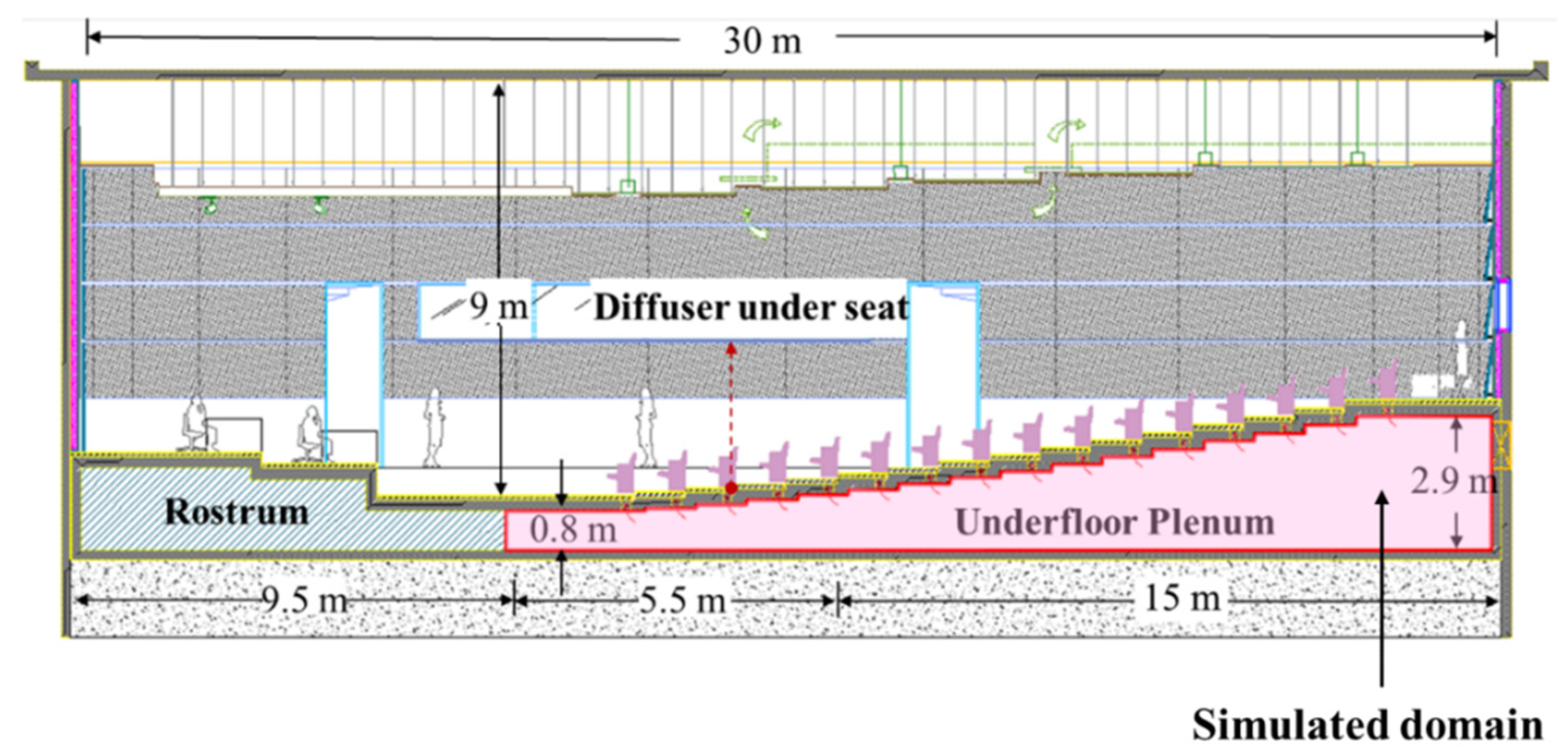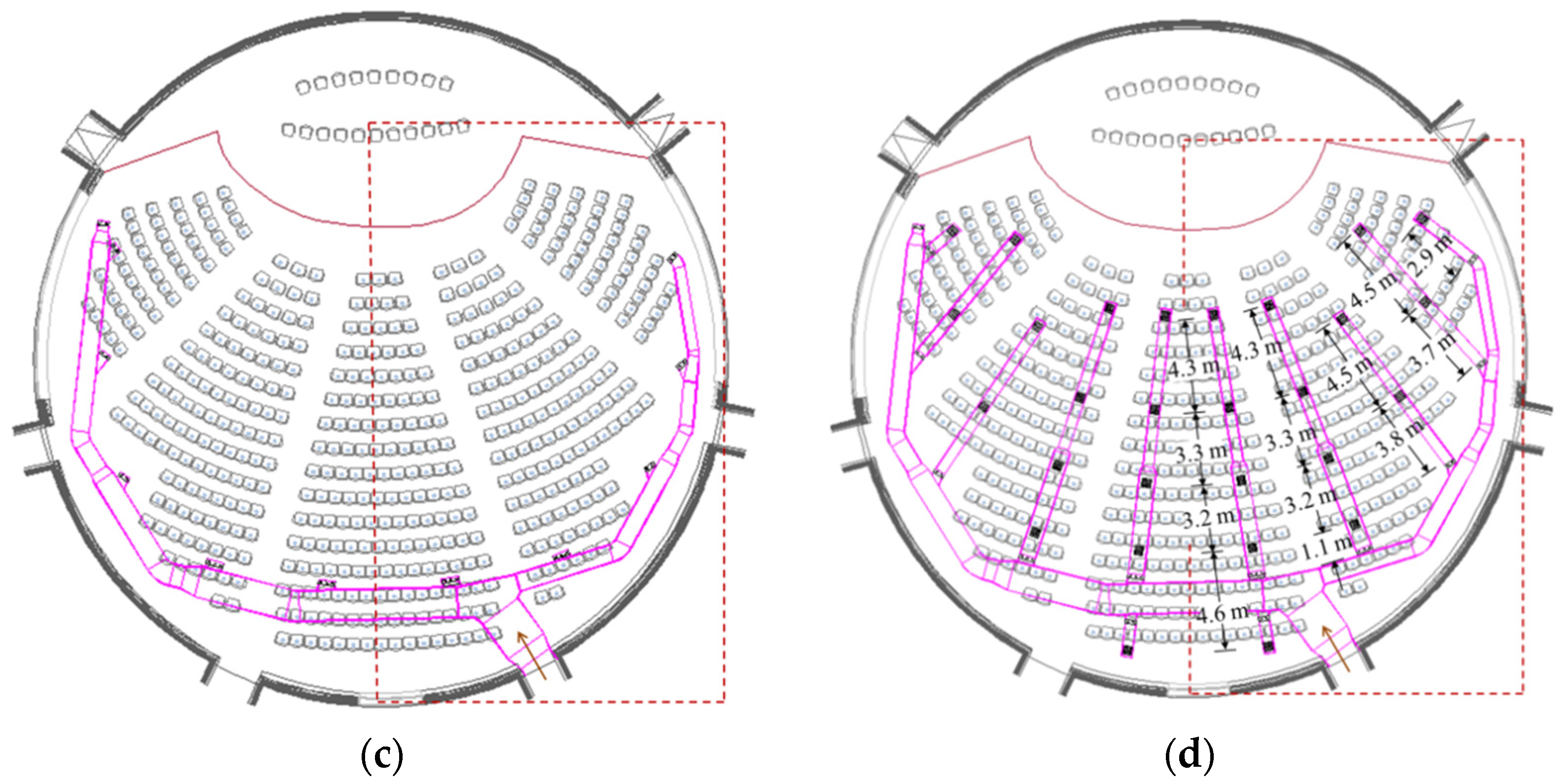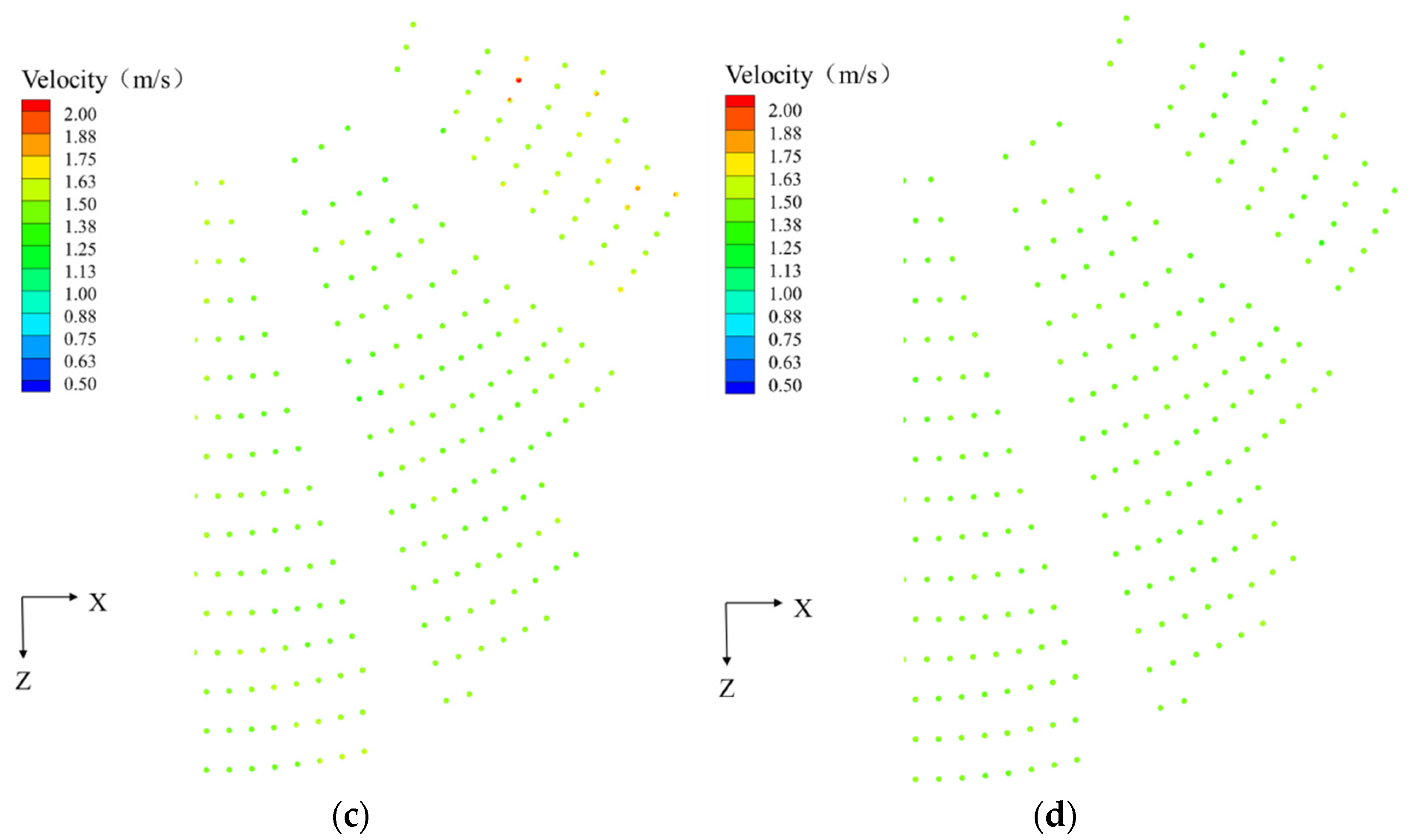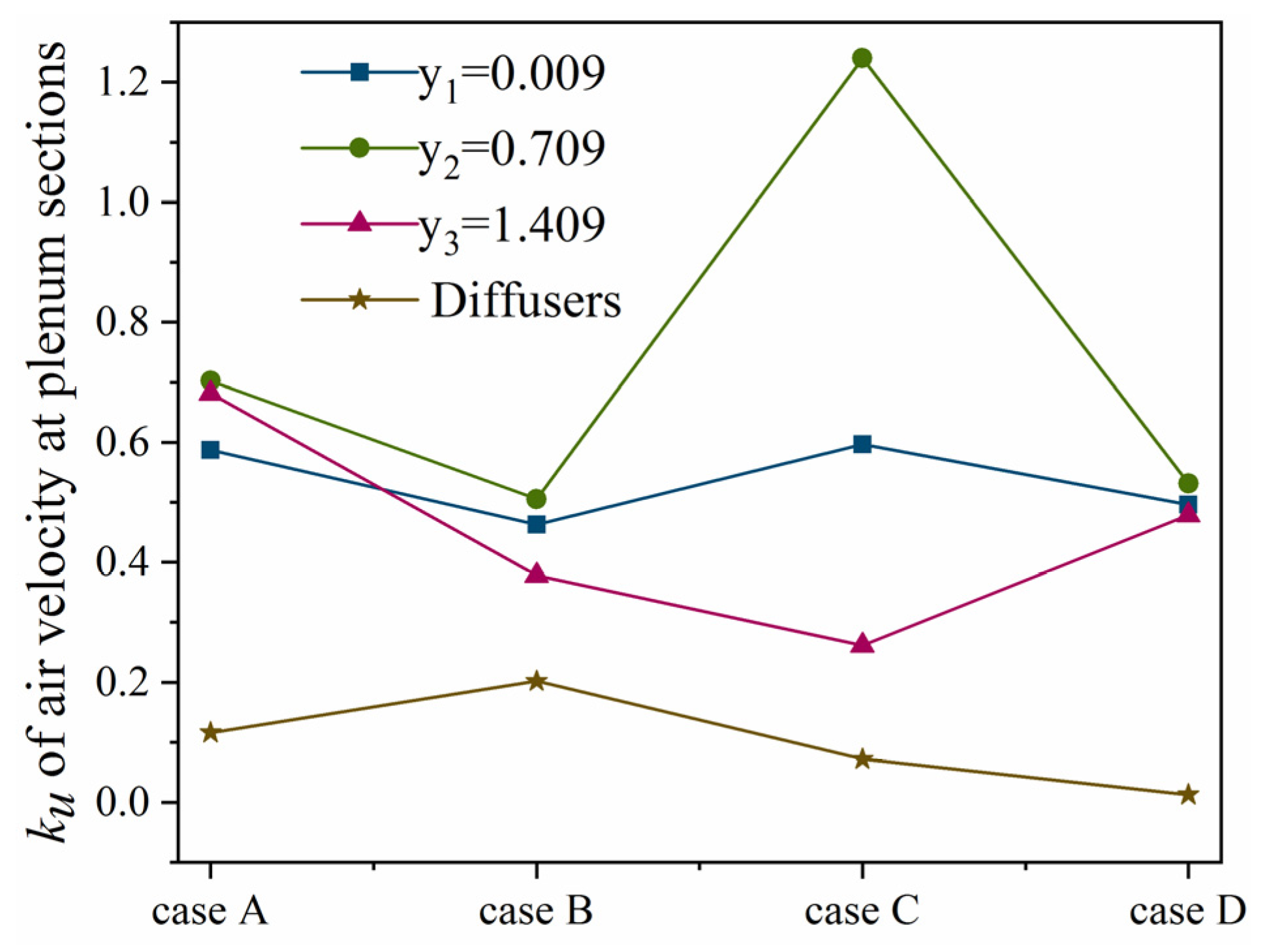Uniformity of Supply Air in the Plenum for Under-Floor Air Distribution Ventilation in a Circular Conference Room: A CFD Study
Abstract
:1. Introduction
2. CFD Simulation
2.1. Three-Dimensional Geometric Model
2.2. Mathematical Model
2.2.1. Governing Equations
- (1)
- The air inside the plenum is an incompressible Newtonian fluid.
- (2)
- The fluid in the plenum is a steady flow system whose density and velocity do not change with time. Moreover, the fluid is viscous, and the dissipative heat caused by viscous force is negligible.
- (3)
- The inner wall of the plenum and the air supply ductwork are well insulated and sealed, so the heat loss and air leakage in the plenum can be neglected.
2.2.2. Turbulence Model
2.3. Boundary Conditions
2.4. Grid Generation
2.5. Solver Algorithm
3. Simulation Setting and Evaluation Indicator
3.1. Studied Cases
3.2. Evaluating Indicators
- (1)
- Non-uniformity coefficient
- (2)
- Velocity limit at diffuser outlet
4. Results and Discussion
4.1. Velocity and Static Pressure Field of Plenum Chamber
4.1.1. Centralized Air Supply Mode
4.1.2. Uniform Air Supply Mode
4.2. Velocity of the Seat Air Outlet
4.3. Air Velocity Non-Uniformity Coefficient
5. Discussion
6. Conclusions
Author Contributions
Funding
Institutional Review Board Statement
Informed Consent Statement
Conflicts of Interest
Nomenclature
| arithmetic average velocity of measuring points (m/s) | |
| Cμ, C1ε, C2ε | adjustable constants |
| Gb | turbulent kinetic energy produced by buoyancy |
| Gk | turbulent kinetic energy produced by average velocity gradient |
| ku | non-uniformity coefficient |
| wu | root mean square deviation (m/s) |
| n | number of monitoring points |
| p | pressure (Pa) |
| S | source term |
| u | air velocity (m/s) |
| ui | average velocity (m/s) |
| ui′ | fluctuating velocity (m/s) |
| YM | fluctuation dilation in compressible turbulence |
| μt | turbulent viscosity (m2/s) |
| σ | Prandtl number |
| Abbreviation | |
| CFD | computational fluid dynamics |
| UFAD | underfloor air distribution |
| Greek symbols | |
| μ | dynamic viscosity (m2/s) |
| ρ | density (kg/m3) |
| k | turbulent kinetic energy |
| ε | turbulent kinetic energy dissipation rate |
References
- Ruparathna, R.; Hewage, K.; Sadiq, R. Improving the energy efficiency of the existing building stock: A critical review of commercial and institutional buildings. Renew. Sustain. Energy Rev. 2016, 53, 1032–1045. [Google Scholar] [CrossRef]
- Wang, Y.M. Simulation and Optimization of Underfloor Air Distribution in Theatre. Master’s Thesis, Central South University, Changsha, China, May 2011. [Google Scholar]
- Nada, S.A.; El-Batsh, H.M.; Elattar, H.F.; Ali, N.M. CFD investigation of airflow pattern, temperature distribution and thermal comfort of UFAD system for theater buildings applications. J. Build. Eng. 2016, 6, 2–52. [Google Scholar] [CrossRef]
- Shokrollahi, S.; Hadavi, M.; Heidarinejad, G.; Pasdarshahri, H. Multi-objective optimization of underfloor air distribution (UFAD) systems performance in a densely occupied environment: A combination of numerical simulation and Taguchi algorithm. J. Build. Eng. 2020, 32, 101495. [Google Scholar] [CrossRef]
- Lee, K.; Zhang, T.F.; Jiang, Z.; Chen, Q.Y. Comparison of Airflow and Contaminant Distributions in Rooms with Traditional Displacement Ventilation and Under-Floor Air Distribution Systems. ASHRAE Trans. 2009, 115, 306–321. [Google Scholar]
- Alajmia, A.; El-Amer, W. Saving energy by using underfloor-air-distribution (UFAD) system in commercial buildings. Energy Convers. Manag. 2010, 51, 1637–1642. [Google Scholar] [CrossRef]
- Karki, K.C.; Patankar, S.V. Airflow distribution through perforated tiles in raised-floor data centers. Build. Environ. 2006, 41, 734–744. [Google Scholar] [CrossRef]
- Zhang, M.; Zhang, Z.B.; Hu, Y.; Geng, Y.; Huang, H.; Huang, Y. Effect of raised floor height on different arrangement of under-floor air distribution performance in data center. Procedia Eng. 2017, 205, 556–564. [Google Scholar] [CrossRef]
- Chen, Y.; Zhao, S.X.; Fan, B.; Wu, S.; Huang, L. Simulation on uniformity of supplied air from plenum chamber of underfloor air distribution systems. Heat. Vent. Air Cond. 2015, 3, 110–112. [Google Scholar]
- Kong, Q.X.; Yu, B.F.; Pan, Z. Numerical simulation on airflow in plenum of underfloor air supply and experiment on characteristics of plenum’s outlets. J. Xi’an Jiaotong Univ. 2005, 39, 531–535. [Google Scholar]
- Tradat, M.I.; Manaserh, Y.M.A.; Sammakia, B.G.; Hoang, C.H.; Alissa, H.A. An experimental and numerical investigation of novel solution for energy management enhancement in data centers using underfloor plenum porous obstructions. Appl. Energy 2021, 289, 116663. [Google Scholar] [CrossRef]
- Lu, H.; Zhang, Z.; Yang, L. A review on airflow distribution and management in data center. Energy Build. 2018, 179, 264–277. [Google Scholar] [CrossRef]
- Jiang, Y.H.; Sun, H.S.; Zhong, J.X. Study and Design of air balance of large-scale static pressure box air conditioner in theaters. J. Qingdao Univ. Technol. 2013, 34, 113–117, 121. [Google Scholar]
- Wang, X.X. The Study of Theatre Large Size Static Pressure Box Internal Air Distribution. Master’s Thesis, Qingdao Technological University, Qingdao, China, December 2012. [Google Scholar]
- Huang, L.; Zhao, S.X.; Wu, S.; Fan, B.; An, Z.H.; Zang, X.G. Affection of action radius of static pressure box and air supply outlet density on uniformity of supply air. Refrig. Air-Cond. 2013, 13, 21–23. [Google Scholar]
- Kim, G.; Schaefer, L.; Lim, T.S.; Kim, J.T. Thermal comfort prediction of an underfloor air distribution system in a large indoor environment. Energy Build. 2013, 64, 323–331. [Google Scholar] [CrossRef]
- Murakami, S.; Kato, S.; Kim, T. Indoor climate design based on CFD coupled simulation of convection, radiation, and HVAC control for attaining a given PMV value. Build. Environ. 2001, 36, 701–709. [Google Scholar] [CrossRef]
- Hayashi, T.; Ishizu, Y.; Kato, S.; Murakami, S. CFD analysis on characteristics of contaminated indoor air ventilation and its application in the evaluation of the effects of contaminant inhalation by a human occupant. Build. Environ. 2002, 37, 219–230. [Google Scholar] [CrossRef]
- Yang, X.Q.; Wang, H.D.; Su, C.X.; Wang, X.; Wang, Y. Heat transfer between occupied and unoccupied zone in large space building with floor-level side wall air-supply system. Build. Simulat. 2020, 13, 1221–1233. [Google Scholar] [CrossRef]
- Kong, Q.X.; Yu, B.F. Numerical study on temperature stratification in a room with underfloor air distribution systems. Energy Build. 2008, 40, 495–502. [Google Scholar] [CrossRef]
- Kobayashi, N.; Chen, Q.Y. Floor-supply displacement ventilation in a small office. Indoor Built Environ. 2003, 12, 281–291. [Google Scholar] [CrossRef]
- Cheong, K.W.D.; Djunaedy, E.; Chua, Y.L.; Tham, K.W.; Sekhar, S.C.; Wong, N.H.; Ullah, M.B. Thermal comfort study of an air-conditioned lecture theatre in the tropics. Build. Environ. 2003, 38, 63–73. [Google Scholar] [CrossRef]
- Nina, S.S.; Łukasz, S. Air leakage modelling and its influence on the air quality inside a garage. E3S Web Conf. 2018, 44, 172. [Google Scholar]
- Nina, S.S.; Antonowicz, A.; Scislo, L. PIV measurement and CFD simulations of an air terminal device with a dynamically adapting geometry. SN Appl. Sci. 2019, 1, 370. [Google Scholar]
- Zhang, M.Y. Higher Engineering Fluid Dynamics; Xi’an Jiaotong University Press: Xi’an, China, 2008. [Google Scholar]
- Tao, W.Q. Numerical Heat Transfer, 2nd ed.; Xi’an Jiaotong University Press: Xi’an, China, 2008. [Google Scholar]
- Zhang, X.H. Simulation of Air Distribution in Plenum Chamber of Under Floor Air Supply in Grand Theatre. Master’s Thesis, Central South University, Changsha, China, 2009. [Google Scholar]
- Abanto, J.; Barrero, D.; Reggio, M.; Ozell, B.t. Airflow modelling in a computer room. Build. Environ. 2004, 39, 1393–1402. [Google Scholar] [CrossRef]
- Zhang, Y.; Zhang, K.; Liu, J.; Kosonen, R.; Yuan, X. Airflow uniformity optimization for modular data center based on the constructal T-shaped underfloor air ducts. Appl. Therm. Eng. 2019, 155, 489–500. [Google Scholar] [CrossRef]
- El-degwy, A.; Mohammed, S.; Khalil, E.E. CFD Application to Improve Infection Control in Office Rooms. ASHRAE Trans. 2020, 126, 220–228. [Google Scholar]
- Lee, J.H.; Moshfeghi, M.; Choi, Y.; Hur, N. A numerical simulation on recirculation phenomena of the plume generated by obstacles around a row of cooling towers. Appl. Therm. Eng. 2014, 72, 10–19. [Google Scholar] [CrossRef]
- Huang, M.H.; Chen, L.; Lei, L.; He, P.; Cao, J.J.; He, Y.L.; Feng, Z.P.; Tao, W.Q. Experimental and numerical studies for applying hybrid solar chimney and photovoltaic system to the solar- assisted air cleaning system. Appl. Energy 2020, 269, 115150. [Google Scholar] [CrossRef]
- Calautit, J.K.; Hughes, B.R.; Nasir, D.S.; Nasir, D.S.N.M. Climatic analysis of a passive cooling technology for the built environment in hot countries. Appl. Energy 2017, 186, 321–335. [Google Scholar] [CrossRef]
- Song, P.; Zhang, Z.B.; Zhu, Y. Numerical and experimental investigation of thermal performance in data center with different deflectors for cold aisle containment. Build. Environ. 2021, 200, 107961. [Google Scholar] [CrossRef]
- Hu, K. ANSYS CFD Start Guide—Fundamentals and Applications of Computational Fluid Dynamics; China Machine Press: Beijing, China, 2018. [Google Scholar]
- ANSYS Inc. ANSYS Fluent Theory Guide 16.0; ANSYS Inc.: Canonsburg, PA, USA, 2015. [Google Scholar]
- Department of Construction Engineering Quality & Safety Supervision; Ministry of Housing and Urban-Rural Development of the P.R. China. National Technical Measures for Design of Civil Construction Heating, Ventilation and Air Conditioning, Beijing; China Planning Publishing House: Beijing, China, 2009; pp. 85–86.
- Liu, G.D.; Wang, X.X.; Wang, X.; Qi, F.; Wang, G.; Hu, S.T. Large Size Static Pressure Box Airflow Distribution. In Proceedings of the 2nd International Conference on Computer and Information Applications (ICCIA), Taiyuan, China, 8–9 December 2012. [Google Scholar]


















| Parameters | Skewness | Orthogonality Quality | Aspect Ratio | Element Quality |
|---|---|---|---|---|
| Average value | 0.22 | 0.86 | 1.84 | 0.86 |
| Outlet Number | 1 | 2 | 3 | 4 | 5 |
|---|---|---|---|---|---|
| Velocity (m/s) | 3.97 | 3.97 | 1.98 | 2.10 | 2.98 |
Publisher’s Note: MDPI stays neutral with regard to jurisdictional claims in published maps and institutional affiliations. |
© 2022 by the authors. Licensee MDPI, Basel, Switzerland. This article is an open access article distributed under the terms and conditions of the Creative Commons Attribution (CC BY) license (https://creativecommons.org/licenses/by/4.0/).
Share and Cite
Fan, X.; Yu, T.; Liu, P.; Li, X. Uniformity of Supply Air in the Plenum for Under-Floor Air Distribution Ventilation in a Circular Conference Room: A CFD Study. Energies 2022, 15, 6370. https://doi.org/10.3390/en15176370
Fan X, Yu T, Liu P, Li X. Uniformity of Supply Air in the Plenum for Under-Floor Air Distribution Ventilation in a Circular Conference Room: A CFD Study. Energies. 2022; 15(17):6370. https://doi.org/10.3390/en15176370
Chicago/Turabian StyleFan, Xiaolei, Tao Yu, Peng Liu, and Xiangdong Li. 2022. "Uniformity of Supply Air in the Plenum for Under-Floor Air Distribution Ventilation in a Circular Conference Room: A CFD Study" Energies 15, no. 17: 6370. https://doi.org/10.3390/en15176370








